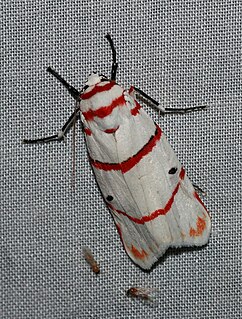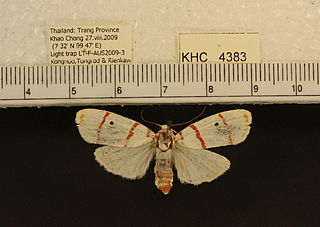
Cyana is a genus of moths in the family Erebidae. Species are well distributed in Africa, Madagascar, China, India, Sri Lanka, Myanmar, Sumatra, Java and Borneo. The genus was erected by Francis Walker in 1854.

Virbia is a genus of tiger moths in the family Erebidae. The genus was erected by Francis Walker in 1854.

Cyana effracta is a moth of the family Erebidae first described by Francis Walker in 1854. It is found in Nepal, the north-eastern Himalayas, Taiwan, China, Burma, Peninsular Malaysia, Sumatra and Borneo.

Cyana sanguinea is a moth of the family Erebidae first described by Otto Vasilievich Bremer and William Grey in 1852. It is found in Taiwan and China.
Cyana amatura is a moth of the family Erebidae first described by Francis Walker in 1863. It is found on Madagascar.
Cyana bicolor is a moth of the family Erebidae. It was described by Walter Rothschild in 1913. It is found in Papua New Guinea.
Cyana delicata is a moth of the family Erebidae. It was described by Francis Walker in 1854. It is found in Angola, the Democratic Republic of the Congo, Ghana, Sierra Leone and Togo.

Cyana conclusa is a moth of the subfamily Arctiinae. It was described by Francis Walker in 1862. It is found on Borneo and Sumatra. The habitat consists of lowland forest types, excluding heath forests.

Cyana perornata is a moth of the family Erebidae. It was described by Francis Walker in 1854. It is found in India and Sundaland. The habitat consists of lowland forests, extending more weakly into lower montane forests.
Cyana heidrunae is a moth of the family Erebidae first described by Henri Hoppe in 2004. It is found on Bioko, an island off the west coast of Africa.
Cyana punctistrigosa is a moth of the family Erebidae. It was described by Walter Rothschild in 1913. It is found in New Guinea.
Cyana rejecta is a moth of the family Erebidae. It was described by Francis Walker in 1854. It is found in the Democratic Republic of the Congo, Ethiopia, Kenya, Malawi, Sierra Leone, South Africa, Tanzania, Gambia and Uganda.
Cyana trigutta is a moth of the family Erebidae. It was described by Francis Walker in 1854. It is found in Cameroon, Niger and Sierra Leone.
Cyana meyricki is a moth of the family Erebidae first described by Walter Rothschild and Karl Jordan in 1901. It is found in Australia, where it has been recorded from Queensland and New South Wales.
Cyana obscura is a moth of the family Erebidae first described by George Hampson in 1900. It is found in Australia, where it has been recorded from Queensland.
Cyana detrita is a moth of the family Erebidae first described by Francis Walker in 1854. The male has a wingspan of 15 mm and the female's is 19 mm.
Cyana subornata is a moth of the family Erebidae first described by Francis Walker in 1854. It is found in India, Borneo and Sri Lanka.






